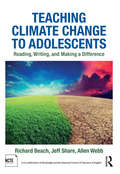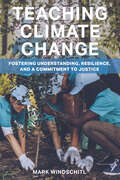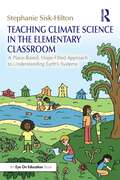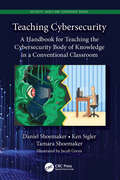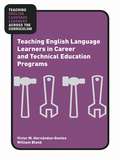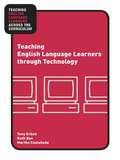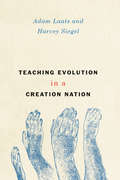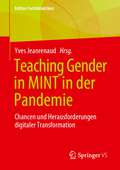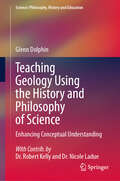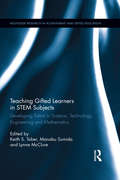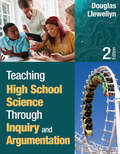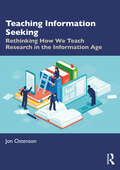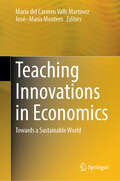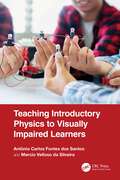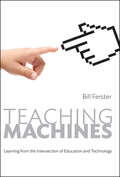- Table View
- List View
Teaching Climate Change to Adolescents: Reading, Writing, and Making a Difference
by Richard Beach Allen Webb Jeff ShareCO-PUBLISHED BY ROUTLEDGE AND THE NATIONAL COUNCIL OF TEACHERS OF ENGLISH Teaching Climate Change to Adolescents is THE essential resource for middle and high school English language arts teachers to help their students understand and address the urgent issues and challenges facing life on Earth today. Classroom activities written and used by teachers show students posing questions, engaging in argumentative reading and writing and critical analysis, interpreting portrayals of climate change in literature and media, and adopting advocacy stances to promote change. The book illustrates climate change fitting into existing courses using already available materials and gives teachers tools and teaching ideas to support building this into their own classrooms. A variety of teacher and student voices makes for an appealing, fast-paced, and inspiring read. Visit the website for this book for additional information and links. All royalties from the sale of this book are donated to Alliance for Climate Education.
Teaching Climate Change: Fostering Understanding, Resilience, and a Commitment to Justice
by Mark WindschitlA practical guide to cultivating expansive understandings of climate change and environmental regeneration in K–12 students through classroom instructional practices and curricula. Teaching Climate Change lays out a comprehensive, NGSS-aligned approach to climate change education that builds in-depth knowledge of the subject, empowers students, and promotes a social justice mindset. In this fortifying and inspiring work, Mark Windschitl guides classroom teachers and educational leaders through an ambitious multilevel, multidisciplinary framing of climate change education as an integral element of school curricula. Exuding hope for the future, Windschitl emphasizes the big picture of research-informed teaching about climate change. He presents real-life classroom examples that illustrate not only key STEM concepts such as carbon cycles and the greenhouse effect, biodiversity, and sustainability, but also broader issues, including the countering of misinformation, decarbonizing solutions, the centering of human stories, and the advancement of equity and environmental justice. Windschitl offers keen advice for using methods such as storytelling, project-based learning, and models of inquiry backed by authoritative evidence as core strategies in science teaching and learning. He also addresses the social-emotional toll that discussion of the climate crisis may exact on both students and teachers. This timely book equips teachers to approach climate education with the urgency and empathy that the topic requires and shows how the classroom can inspire students to activism.
Teaching Climate Science in the Elementary Classroom: A Place-Based, Hope-Filled Approach to Understanding Earth’s Systems
by Stephanie Sisk-HiltonDiscover new ways to help elementary students engage with and understand the world around them through place-based, hope-filled learning about the causes, impacts, and responses to climate change. This book features foundational climate concepts, easily implementable activity plans, and inspiring examples of student engagement. Each chapter begins with a short vignette pulled from the author’s considerable teaching experience in engaging students in concepts of climate change and climate justice, followed by content-focused sections and recommendations for student activities and projects. The author provides stories of hope-filled action to invite teachers to look for and reflect on similar narratives in their own communities. Sample units of study for grades K-5 show teachers how key ideas from each chapter come together into an instructional plan that incorporates the three dimensions of NGSS and can fit into the broader outline of their school year. This resource is an accessible tool to support any elementary educator in building their own knowledge base and integrating the important and timely issues of climate change into their classroom.
Teaching Cybersecurity: A Handbook for Teaching the Cybersecurity Body of Knowledge in a Conventional Classroom (Security, Audit and Leadership Series)
by Ken Sigler Daniel Shoemaker Tamara ShoemakerLet’s be realistic here. Ordinary K-12 educators don’t know what "cybersecurity" is and could probably care less about incorporating it into their lesson plans. Yet, teaching cybersecurity is a critical national priority. So, this book aims to cut through the usual roadblocks of confusing technical jargon and industry stovepipes and give you, the classroom teacher, a unified understanding of what must be taught. That advice is based on a single authoritative definition of the field. In 2017, the three societies that write the standards for computing, software engineering, and information systems came together to define a single model of the field of cybersecurity. It is based on eight building blocks. That definition is presented here. However, we also understand that secondary school teachers are not experts in arcane subjects like software, component, human, or societal security. Therefore, this book explains cybersecurity through a simple story rather than diving into execution details. Tom, a high school teacher, and Lucy, a middle school teacher, are tasked by their district to develop a cybersecurity course for students in their respective schools. They are aided in this by "the Doc," an odd fellow but an expert in the field. Together they work their way through the content of each topic area, helping each other to understand what the student at each level in the educational process has to learn. The explanations are simple, easy to understand, and geared toward the teaching aspect rather than the actual performance of cybersecurity work. Each chapter is a self-contained explanation of the cybersecurity content in that area geared to teaching both middle and high school audiences. The eight component areas are standalone in that they can be taught separately. But the real value lies in the comprehensive but easy-to-understand picture that the reader will get of a complicated field.
Teaching Electromagnetics: Innovative Approaches and Pedagogical Strategies
by Karl F. Warnick Krishnasamy T. SelvanTeaching Electromagnetics: Innovative Approaches and Pedagogical Strategies is a guide for educators addressing course content and pedagogical methods primarily at the undergraduate level in electromagnetic theory and its applications. Topics include teaching methods, lab experiences and hands-on learning, and course structures that help teachers respond effectively to trends in learning styles and evolving engineering curricula. The book grapples with issues related to the recent worldwide shift to remote teaching. Each chapter begins with a high-level consideration of the topic, reviews previous work and publications, and gives the reader a broad picture of the topic before delving into details. Chapters include specific guidance for those who want to implement the methods and assessment results and evaluation of the effectiveness of the methods. Respecting the limited time available to the average teacher to try new methods, the chapters focus on why an instructor should adopt the methods proposed in it. Topics include virtual laboratories, computer-assisted learning, and MATLAB® tools. The authors also review flipped classrooms and online teaching methods that support remote teaching and learning. The end result should be an impact on the reader represented by improvements to his or her practical teaching methods and curricular approach to electromagnetics education. The book is intended for electrical engineering professors, students, lab instructors, and practicing engineers with an interest in teaching and learning. In summary, this book: Surveys methods and tools for teaching the foundations of wireless communications and electromagnetic theory Presents practical experience and best practices for topical coverage, course sequencing, and content Covers virtual laboratories, computer-assisted learning, and MATLAB tools Reviews flipped classroom and online teaching methods that support remote teaching and learning Helps instructors in RF systems, field theory, and wireless communications bring their teaching practice up to date Dr. Krishnasamy T. Selvan is Professor in the Department of Electronics & Communication Engineering, SSN College of Engineering, since June 2012. Dr. Karl F. Warnick is Professor in the Department of Electrical and Computer Engineering at BYU.
Teaching English Language Learners in Career and Technical Education Programs
by Victor M. Hernández-Gantes William BlankExploring the unique challenges of vocational education, this book provides simple and straightforward advice on how to teach English Language Learners in today's Career and Technical Education programs. The authors' teaching framework and case studies draw from common settings in which career and technical educators find themselves working with ELLs—in the classroom, in the laboratory or workshop, and in work-based learning settings. By integrating CTE and academic instruction, and embedding career development activities across the curriculum, readers will gain a better understanding of the challenges of teaching occupationally-oriented content to a diverse group of learners in multiples settings.
Teaching English Language Learners through Technology
by Tony Erben Ruth Ban Martha CastañedaIn Teaching English Language Learners through Technology, the authors explore the use of computers/technology as a pedagogical tool to aid in the appropriate instruction of ELLs across all content areas. The special focus of this book is on the informed use of various technologies and software programs that can specifically aid ELLs. Strategies are also provided for varying levels of access--whether teachers teach in a one computer classroom, have access to multiple computers, or have the ability to go into a computer lab at their school. A fully annotated list of web and print resources completes the volume, making this a valuable reference to help teachers harness the power of computer-assisted technologies in meeting the challenges of including all learners in effective instruction.
Teaching Evolution in a Creation Nation
by Adam Laats Harvey SiegelNo fight over what gets taught in American classrooms is more heated than the battle over humanity's origins. For more than a century we have argued about evolutionary theory and creationism (and its successor theory, intelligent design), yet we seem no closer to a resolution than we were in Darwin's day. In this thoughtful examination of how we teach origins, historian Adam Laats and philosopher Harvey Siegel offer crucial new ways to think not just about the evolution debate but how science and religion can make peace in the classroom. Laats and Siegel agree with most scientists: creationism is flawed, as science. But, they argue, students who believe it nevertheless need to be accommodated in public school science classes. Scientific or not, creationism maintains an important role in American history and culture as a point of religious dissent, a sustained form of protest that has weathered a century of broad--and often dramatic--social changes. At the same time, evolutionary theory has become a critical building block of modern knowledge. The key to accommodating both viewpoints, they show, is to disentangle belief from knowledge. A student does not need to believe in evolution in order to understand its tenets and evidence, and in this way can be fully literate in modern scientific thought and still maintain contrary religious or cultural views. Altogether, Laats and Siegel offer the kind of level-headed analysis that is crucial to finding a way out of our culture-war deadlock.
Teaching Gender in MINT in der Pandemie: Chancen und Herausforderungen digitaler Transformation (Edition Fachdidaktiken)
by Yves JeanrenaudDer Band widmet sich der Frage, ob und wie sich die Corona-Pandemie auf das Themenfeld Gender in der MINT-Hochschullehre spezifisch auswirkte und weiterhin auswirkt. Dabei werden Aspekte der digitalen Transformation der MINT-Hochschullehre während der Corona-Krise analysiert und Einblicke in die Voraussetzungen, Prozesse und Folgen der Auseinandersetzung mit dem Thema Gender in diesem Zusammenhang beleuchtet.
Teaching Geology Using the History and Philosophy of Science: Enhancing Conceptual Understanding (Science: Philosophy, History and Education)
by Glenn DolphinThis book provides a case study on how to design and build an introductory geology course for non-science majors. The book presents a foundation with the status of geoscience education and research in geoscience conceptual development as a backdrop for the design process. It then describes the instructional goal-setting process and development of the structural components of the course based on the determined goals. The book presents the three historical narratives (the earth is a historical entity, the earth is very old, and the earth is dynamic) that form the foundation of instruction. It also describes examples of the implicit, explicit, and reflective treatments of the nature of science to help student develop a better sense of the process of geology. Finally, the book gives preliminary results from some innovative approaches to research on student learning within the domains of geological content knowledge and NOS content knowledge within the course.
Teaching Gifted Learners in STEM Subjects: Developing Talent in Science, Technology, Engineering and Mathematics (Routledge Research in Achievement and Gifted Education)
by Keith S. Taber Manabu Sumida Lynne McClureThis book offers an overview of programmes designed to support the learning of gifted and talented students in STEM subjects, both to allow them to meet their potential and to encourage them to proceed towards careers in STEM areas. The chapters from a range of national contexts report on perspectives, approaches and projects in gifted education in STEM subjects. These contributions provide a picture of the state of research and practice in this area, both to inform further research and development, and to support classroom teachers in their day-to-day work. Chapters have been written with practitioners in mind, but include relevant scholarly citations to the literature. The book includes some contributions illustrating research and practice in specific STEM areas, and others which bridge across different STEM subjects. The volume also includes an introductory theoretical chapter exploring the implications for gifted learners of how 'STEM' is understood and organized within the school curriculums.
Teaching High School Science Through Inquiry and Argumentation (2nd Edition)
by Douglas J. LlewellynProven ways to teach next generation science! To ensure our students achieve scientific literacy, we need to know what works in science teaching. One thing we know for certain: inquiry and argumentation are key. This groundbreaking book for Grades 9–12 addresses the new direction of science standards by emphasizing both inquiry-based and argument-based instruction. Filled with case studies and vignettes, this edition features: Exceptional coverage of scientific argumentation Enhanced chapters on assessment and classroom management Questioning techniques that promote the most learning Activities that emphasize making claims and citing evidence New examples of inquiry investigations New approaches to traditional labs
Teaching Information Seeking: Rethinking How We Teach Research in the Information Age
by Jon OstensonTeaching Information Seeking redefines how we approach research and information literacy in today's information-rich world, inviting teachers to re-imagine teaching research.The book combines insights from fields such as library and information sciences, journalism, and media literacy to offer fresh strategies and perspectives for guiding students through evolving landscapes of information.While a focus on concepts and skills has long been important in teaching research, this book integrates significant new understandings about the role dispositions play in how well students embrace and utilize skill-based knowledge. The book provides conceptual knowledge and learning activities that support writing teachers as they help students learn throughout the research or inquiry process of asking questions, finding information, and sharing their learning purposefully and ethically. Chapters with a pedagogical focus and approach include activities informed by the author’s decades of experience teaching writing. These activities are described in depth, including assignment prompts, sample work, and scripts for think-aloud protocols and discussions the author has led that engage students in deeper learning around these critical skills and dispositions. Teaching Information Seeking serves as a comprehensive guide for educators looking to foster meaningful information literacy and critical thinking skills in their students.This book is ideal for teachers and teacher educators who want to equip students with the skills and dispositions needed for effective research and information literacy. Readers will find teacher-friendly, research-grounded insights and activities that can be readily applied in the classroom.
Teaching Innovations in Economics: Towards a Sustainable World
by José–María Montero María del Carmen Valls MartínezThis book highlights the latest technological innovations in economics education. Economics, as a discipline, not only studies the relationship between ends and scarce means, which can be used alternatively, but also serves as a social science that uses historical data to predict future events—a task complicated by the influence of human behavior. In economics, a solid theoretical foundation alone is insufficient; practical application requires a deep understanding of statistics. With the vast amount of information available today, data processing is now performed using specialized software. Consequently, teaching economics demands a wide range of complex skills that have significantly evolved in recent years, driven by the growing interest in educational innovation among professors and scientists, further accelerated by advancements in new technologies. Moreover, economics education is increasingly aligned with the global concern for sustainability, as emphasized in the United Nations' Agenda 2030. Professors are now integrating sustainability into syllabi and teaching methodologies. This book covers key topics such as: Technological and innovative advancements in economics education. New teaching-learning theories and models in economics education. The impact of digital transformation on economics education. The role of artificial intelligence in economics education. Addressing special educational needs in economics education. Evaluation of the teaching-learning process in economics. Assessment of student learning in economics. Development of materials and tools for economics education. Final projects (Undergraduate and Master's) in economics. Authored by leading professors and researchers in the field, this book presents a collection of chapters that rigorously explore teaching innovations in economics.
Teaching Introductory Physics to Visually Impaired Learners
by Antônio Carlos dos Santos Marcio Velloso da SilveiraFollowing global inclusion policies and initiatives, more students with visual impairments are attending regular education in inclusive schools. Universities also increasingly accept students with visual impairments in the most varied courses, including engineering and physics. However, teachers do not always have experience with teaching this specific audience. Teaching Introductory Physics to Visually Impaired Learners provides a gateway to understanding the difficulties encountered by this audience and provides ways for teachers to embrace this challenge. The concept of inclusion is discussed in light of the historical evolution of the achievements of people with disabilities and the development of reading and writing in Braille, in addition to other more modern tools, such as cell phone applications. The remaining chapters present methodologies for teaching mechanics, waves, electrodynamics, optics, and modern physics in classes where there are one or more students with visual impairments. The main target audience for this book is elementary and higher education physics teachers and researchers. This book is also of great value to anyone, including teachers from other areas and students with visual impairments, who are looking for teaching materials that facilitate learning for people with visual impairments.Key Features: The first book to help readers understand the difficulties of inclusive physics teaching for students with visual impairment. Allows the reader to have a broader view of what visual impairment is, bringing together theoretical tools necessary to value and promote inclusive education. Encourages the reader to reproduce the physics teaching methodology, with low-cost materials, which facilitates its implementation in the classroom.
Teaching Machines: Learning from the Intersection of Education and Technology (Tech.edu: A Hopkins Series on Education and Technology)
by Bill FersterTechnology promises to make learning better, cheaper, faster—but rarely has it kept that promise.The allure of educational technology is easy to understand. Classroom instruction is an expensive and time-consuming process fraught with contradictory theories and frustratingly uneven results. Educators, inspired by machines’ contributions to modern life, have been using technology to facilitate teaching for centuries.In Teaching Machines, Bill Ferster examines past attempts to automate instruction from the earliest use of the postal service for distance education to the current maelstrom surrounding Massive Open Online Courses. He tells the stories of the entrepreneurs and visionaries who, beginning in the colonial era, developed and promoted various instructional technologies. Ferster touches on a wide range of attempts to enhance the classroom experience with machines, from hornbooks, the Chautauqua movement, and correspondence courses to B. F. Skinner’s teaching machine, intelligent tutoring systems, and eLearning. The famed progressive teachers, researchers, and administrators that the book highlights often overcame substantial hurdles to implement their ideas, but not all of them succeeded in improving the quality of education. Teaching Machines provides invaluable new insight into our current debate over the efficacy of educational technology.
Teaching Philosophy in Early Modern Europe: Text and Image (Archimedes #61)
by Daniel Garber Susanna BergerThis book examines how philosophy was taught in the early modern period in Europe. It breaks new ground in a number of ways. Firstly, it seeks to bring text-based scholars in the history of philosophy together with social and cultural historians to examine the interaction between tradition and innovation in the early modern classroom, the site where traditional views of the world were transmitted to the generation that was to give birth to modern philosophy and science. Secondly, it draws together scholars who are centered on ideas and words with other scholars who focus on the role of images in the classroom and the intellectual world in this central period of history. The volume advances our understanding of how philosophy was understood and transmitted in this rich and crucial era. The principal audience for Teaching Philosophy are historians of science, philosophy, art, visual culture, and print culture. The chapters are written in a tone accessible to upper-level undergraduates and graduate students. It also reaches non-specialist readers interested in subjects including the “scientific revolution,” the organization of information, and Renaissance and Baroque visual art.
Teaching Practical Theatrical 3D Printing: Creating Props for Production
by Robert C. BerlsTeaching Practical Theatrical 3D Printing: Creating Props for Production is a cohesive and practical guide for instructors teaching 3D printing techniques in stagecraft, costume and props courses.Written for the instructor, this book uses non-technical language to explain 3D printers, their workflows and products. Coverage includes the ins and outs of multiple filaments, pros and cons of different types of printers, shop or laboratory setup and safety concerns. The book features lesson plans, rubrics and class-tested sample student projects from design to finished product that highlight learning objectives and methodologies, as well as software and hardware usage explanations and common problems that can occur within design and printing. Step-by-step instructions are included for many types of projects, including fake noses, candlestick phones, buttons, 3D scans, historical recreations and linear actuators. The book also contains examples of poor, average and excellent work with grading explanations and guidance on how to help the student move to the next level with their projects. Chapter objectives, chapter summaries, checklists and reflection points facilitate an instructor in gaining confidence with 3D printers and incorporating their use in the classroom.Teaching Practical Theatrical 3D Printing is an excellent resource for instructors of Props and Costume Design and Construction courses that are interested in using state of the art tools and technology for theatre production.Fully editable files for every object featured in the book are available at www.routledge.com/9781032453279, allowing readers to jump-start their projects and giving them the flexibility to change and redesign the items to best fit their needs.
Teaching Problem-Solving and Thinking Skills through Science: Exciting Cross-Curricular Challenges for Foundation Phase, Key Stage One and Key Stage Two
by Andrew Berry Belle Wallace Diana CaveThis highly practical resource book presents ways in which teachers can help to develop children's problem-solving and thinking skills through a range of exciting science topics. The book contains classroom-based activities which have been trialled and evaluated by teachers and children, and helpfully shows how the skills developed through rigorous scientific investigations can be used across all areas of the curriculum. The scientific curriculum requirements are extended with exciting and inspiring problem-solving activities that use scientific skills, for example: fair-testing pattern-seeking surveying classifying and identifying investigations over time designing testing and adapting an artefact open-ended exploration The book contains learning objectives for each activity, step by step guidelines for carrying out each problem-solving activity, basic equipment that's needed, examples of learner's work and guidelines for assessment. This book is a must-buy for all early years and primary school teachers keen to encourage an inclusive but differentiated approach to the development of problem-solving and thinking skills in their pupils.
Teaching STEAM Through Hands-On Crafts: Real-World Maker Lessons for Grades 3-8
by Amanda Haynes Christine G. SchnittkaHelp your students connect historic technologies with today’s STEAM concepts through the lens of crafting! This book, written by a science education professor and a middle school STEM teacher, provides guidance for turning classic crafts into transdisciplinary STEAM lessons for grades 3–8. Ready-to-use lessons outline the history, science, mathematics, and engineering embedded within ten hands-on crafts from around the world. Each chapter outlines the history of a craft, its social impact, and the mathematics, engineering, and scientific concepts and skills embedded in the craft. Content standards from art, history, English language arts, technology, mathematics, and science are embedded within each unit. Lessons are supplemented with ready-to-photocopy handouts, guiding questions, and logistical support such as shopping lists and safety procedures. Activities have all been classroom-tested to ensure appropriate leveling and applicability across STEAM disciplines. Ideal for any STEM or STEAM classroom across upper elementary and middle schools, this book helps make STEM concepts meaningful and tangible for your students. Rather than just reading about science, technology, mathematics, or engineering, students will become makers and engage in STEAM directly, just as original crafters have done for centuries.Additional instructional materials are available at: https://steamcrafts.weebly.com/
Teaching STEM For Dummies
by Andrew Zimmerman JonesSpark a passion for STEM Teaching STEM For Dummies is an easy-to-read and exciting new guide for teachers who want to inspire their students with engaging lessons and thoughtful discussions about science, technology, engineering, and mathematics. This practical roadmap to developing hands-on classroom material relevant to the real world shows you how to define STEM topics and overcome the most common challenges to teaching these complex subjects to younger students. You'll learn how you can make STEM more welcoming—using inclusion, scaffolding, and differentiation—and discover resources for STEM teachers you can deploy immediately in your classroom. Inside the book: Understand the STEM concepts students are expected to learn at different grades and how to connect those ideas together in engaging lessons Teach your students the inquisitive mindsets, logical reasoning, and collaboration skills they'll need to succeed in STEM fields Increase STEM inclusivity in both the classroom and the industry by engaging all students in STEM from early ages Discover resources to educate students on the problem-solving concepts at the core of STEM subjects Perfect for teachers, homeschooling parents, tutors, and other educators, Teaching STEM For Dummies is a can't-miss read for anyone who wants to open young minds to the wonders of STEM.
Teaching STEM in the Early Years
by Sally MoomawThe foundation for science, technology, engineering, and mathematics (STEM) education begins in the early years. This book provides more than ninety activities and learning center ideas that seamlessly integrate STEM throughout early childhood classrooms. These hands-on STEM experiences enhance cooking, art, and music activities, block play and sensory table exploration, and field trips and outdoor time. Information on assessment and early learning standards is also provided.Sally Moomaw, EdD, has spent much of her career researching and teaching STEM education. She is an assistant professor at the University of Cincinnati and the author of several early education books.
Teaching STEM in the Secondary School: Helping Teachers Meet The Challenge
by David Barlex Frank BanksThis book looks at the purpose and pedagogy of STEM teaching and explores the ways in which STEM subjects can interact in the curriculum to enhance student understanding, achievement and motivation. By reaching outside their own classroom, teachers can collaborate across STEM subjects to enrich learning and help students relate school science, technology and maths to the wider world. Packed with ideas and practical details for teachers of STEM subjects, the new revised edition of this book: ■ considers what the STEM subjects contribute separately to the curriculum and how they relate to each other in the wider education of secondary school students; ■ describes and evaluates different curriculum models for STEM; ■ suggests ways in which a critical approach to the pedagogy of the classroom, laboratory and workshop can support and encourage all pupils to engage fully in STEM; ■ addresses the practicalities of introducing, organising and sustaining STEM-related activities in the secondary school; ■ looks to ways schools can manage and sustain STEM approaches in the long-term. This new revised edition is essential reading for trainee and practising teachers, those engaged in further professional development and all who wish to make the learning of science, technology, engineering and mathematics an interesting, motivating and exciting experience for their students.
Teaching Science
by Jenny Frost Richard B. IngleFirst published in 1995. Routledge is an imprint of Taylor & Francis, an informa company.
Teaching Science
by Ralph LevinsonScience education has undergone far-reaching changes in the last fifty years. The articles collected together in this reader examine how we have reached our present consensus and what theories we now use to explain how children learn science. The central sections of the reader examine how all this can be translated into effective and stimulating teaching, how learning can be most accurately and fairly assessed and how the impact of gender, ethnicity and other factors on children's performance can be addressed in methods of teaching which make science accessible to all. The articles in the final section of the book are a reminder that the debate is not finished yet and raise some challenging questions about what science education is and what it is for.
